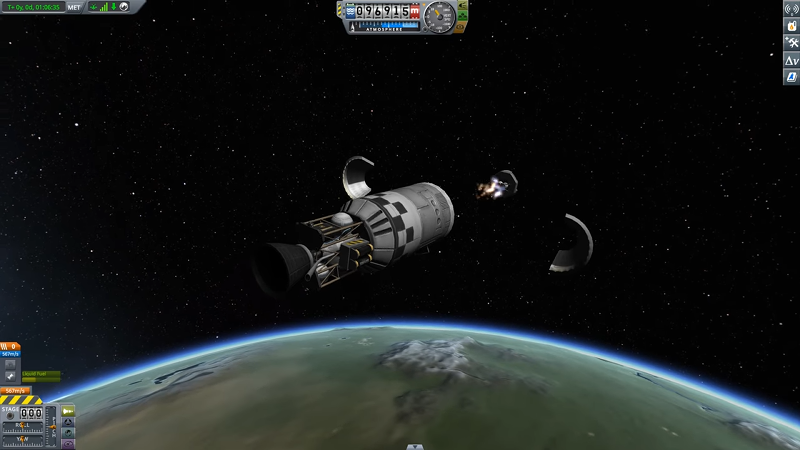We take orbital imagery for granted these days, but there was a time that it was high technology and highly secretive. [Scott Manley] has a good overview of the CIA’s Corona spy satellites, along with declassified images from the early days of the program.
It seems strange today, but the spy images needed high resolution and the only practical technology at the time was film. The satellite held a whopping 3,000 feet of film and, once shot, a capsule or bucket would return to Earth for retrieval and development. They didn’t make it to land — or at least they weren’t supposed to. The CIA didn’t want opponents sweeping up the film so an airplane was supposed to snag the bucket as it descended on a parachute, a topic covered in [Tom Nardi’s] article about the history of catching stuff as it falls from space.
The early cameras could see detail down to about 40 feet. By the end of the program in the 1970s, improved cameras could see down to 3 feet or less. Later satellites had a 3D-capable camera and multiple return buckets. The satellites were — officially — a program to expose biological samples to the space environment and return them for analysis. The Discover program was pure cover and the whole thing was declassified in 1992.
Of course, film from airplanes also had a role. Some spy satellites tried to scan film and send the data back, but that saw more use on lunar missions where returning a capsule to Earth was a lot more difficult.















“It seems strange today, but the spy images needed high resolution and the only practical technology at the time was film.”
The U2 still uses film, and for a reason
https://petapixel.com/2018/06/08/film-photography-at-70000-feet-in-the-u-2-spy-plane/
Grain of salt… The referenced link contains many factual errors (including the comments section). I can’t list them all on mobile.
Credentials: I’ve been maintaining imagery sensors on the U-2 since 1996.
The petapixel article is from 2018. I wonder if film is still the best way to do the kinds of photography that the U2 takes. The answer is probably still classified :).
Film is no longer used on the U-2 platform, with all of the camera systems recently decommissioned.
Could this title be more sensational? Let us know down in the comments.
Yes, yes it could.
Reads like: “The reason the U-2 still uses film is because imagery from the old system can be classified at SECRET or even less for dissemination to allied regional forces. The US digital system is still NOFORN–not for foreign dissemination”
The ONLY reason the U-2 still has film is for ONE mission in particular. It is dictated by treaty that imagery be provided via film media, due to distrust in digital imaging.
Just realized reading into that the 4×5 format is equivalent to ~300 million or Megapixels. Reads like the 16K 1:1 aspect ratio digital system is close at ~270 Megapixels. https://en.wikipedia.org/wiki/16K_resolution
Guessing either format can be process automated for further inspection with similar stereo or multidimensional aspects for more measurement capabilities. Wondering what the AI processing range of capabilities can afford?
I just had an epiphany moment realizing film data density is way more efficient and maybe cost effective I’m thinking. Wondering what those metrics look like and the graph over time comparing the metrics? Comparing for example the number of images of equal resolution on film to the size of a SSD that was 5×5″ and equal thickness?
The funny thing about spy satellites is that they were developed in response to the USSR rejecting the “Open Skies” proposal of the U.S. Spy planes would have been much easier to track (and since under Open Skies time and course would be given to the other party beforehand) and much easier to spoof (see the U.S. Ghost Army) but because the USSR was more distrustful than clever the made Uncle Sam develop spy satellites which had (eventually) better capacity than spy planes and could not be shot down if needed. Also think of how much spy satellites helped the technology used for civilian satellites, unintended consequences.
The United’s States Central Intelligence Agency (CIA) loved to gather intelligence and invented the Corona Project carried out by the United States Air Force. The satellites were launched into a specific orbit for the needs of the CIA and once the desired photographs were taken the film pod was ejected for reentry and recovery. The recovery was made by attaching static prongs or stakes on the nose of a C-119 affectionately know as the “Flying Boxcar” as it reassembled a railroad boxcar with wings. The aircraft was flown towards an intercept with the descending satellite where the aircraft would snag the cable and trail to the rear of the aircraft where the flight crew would reach out with a pole and reel it inside. My father flew these missions.
Inside joke –
In early attempts, quite a lot of film was ruined by static electric discharges that only happened in a really good vacuum – like orbit. Eg, corona.
Took a couple of redesigns to fix that problem.
Even funnier, the film we use today still has occasional problems with static discharge, due to very low amounts of humidity in the U-2’s Q-bay at altitude (leading to dendritic static in the imagery).
I enjoyed the diagrams (internal and external) of the various spacecraft on the video.
“This is the bucket CIA used to get Corona back from space.. and hopefully i will not be demonetised for saying this”
This made my day.